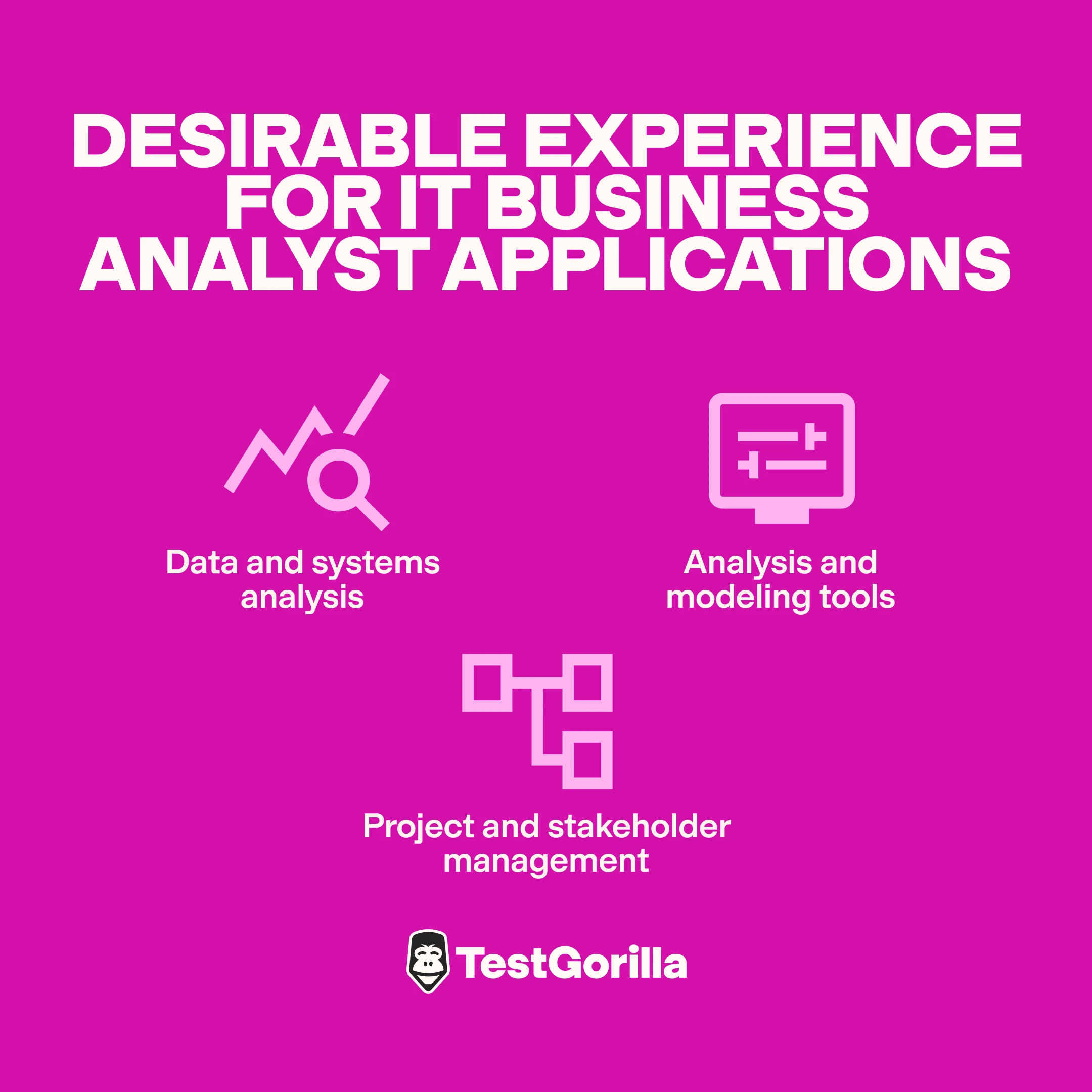40 interview questions for IT business analysts
If you’re looking to hire an IT business analyst, you’ll need to stage interviews. And during those interviews, you’ll need to ask the right questions so you can effectively determine who to hire from your shortlist of candidates.
This blog post is here to help hiring managers and recruiters, as well as candidates who are curious about how their interview process might go. Read on for all the info you could possibly need on interviewing applicants for IT business analyst roles.
Table of contents
- Why should I hire an IT business analyst?
- Using skills assessments before interview
- 15 interview questions about IT
- 5 sample answers to questions about IT
- 15 interview questions about business
- 5 sample answers to questions about business
- 10 general IT business analyst interview questions
- 5 top tips for hiring IT business analysts
Why should I hire an IT business analyst?
An IT business analyst does the same thing as a business analyst but concentrates on IT system-related projects or projects that rely heavily on technology and IT to resolve a business’s problems and optimize its performance.
IT business analysts have combined expertise in both information technology and business management and administration. Top candidates for this role will have the skills to assess and improve the quality of a company’s IT services, products, and internal procedures.
Consider hiring an IT business analyst when:
you need someone who can interpret data,
your company needs someone to determine its IT-related concerns,
and you need someone who can identify solutions.
Top candidates for the IT business analyst role will be able to effectively manage requirements and implement IT business system solutions to help you reach your objectives.
Before you start advertising, it’s worth keeping in mind that IT business analysts are also sometimes referred to as:
Systems analysts
Data analysts
IT analysts
ICT business analysts
IT consultants
Requirements engineers
Writing a job description
In order to write a good job description for an IT business analyst, you’ll need to consider the roles and responsibilities of the job and communicate them in your advertisements. You should also communicate any specific requirements and explain what the recruitment process will entail. This way, applicants know exactly what they’re in for.
IT business analyst roles and responsibilities
There’s a range of possible job responsibilities you might list for IT business analyst applicants. Typical duties might include the following.
Communicating between the IT team and the rest of the company (for example: marketing, customer service, HR, finance)
Using modeling tools to identify and analyze the IT needs of a business
Finding IT solutions and creating IT project plans for your business’s problems
Developing strategies for business costs and reporting optimization
Helping to design or build a new IT system/software-based platform and its features
Helping to integrate effective new IT systems into a business
Negotiating and managing a company’s business requirements with its stakeholders at all levels
Implementing staff training for new IT software, systems and processes
IT business analyst applicant requirements
Experience is not a reliable indicator of job success. This is why using CVs and resumes alone, which have an emphasis on education and previous experience, is an inefficient way of doing recruitment that leads to employment bias and mishires.
Because of this, the most efficient and effective way to hire the best candidates is to give them a pre-employment assessment, but if you’re hiring for an expert IT business analyst you should still list any requirements that are necessary for your applicants to have.
A few examples might be:
A degree in computing, computer engineering, IT, business management or administration, or another related area
Some experience in a technology-based position
Some experience in an IT management role
For most employers, a degree is required for this role. The following experience also tends to be desirable:
Data and systems analysis
Analysis and modeling tools
Project and stakeholder management
Using skills assessments before interview
Even if you write an ultra-specific job ad, you won’t want to interview all of your applicants. To save time and make your recruitment funnel as efficient as it can be, you should shortlist the best candidates from your pool of applicants and invite them for interviews.
Using pre-employment skills assessments is the most reliable way to determine which of your candidates you should invite to the final stage of the hiring process. Pre-employment skills testing reduces hiring costs, time to hire, and company turnover.
Research conducted by the Aberdeen Group reveals that companies who use pre-hire assessments report a 39% lower turnover rate
HRgrapevine.com (2019)
To help you implement skills assessments as a part of your IT business analyst recruitment process, we’ve teamed up with subject matter experts to create an IT business analyst test. This is the best way to narrow down your group of applicants to a shortlist.
Relevant and related skills for IT business analysts
Below are some related skills that you might also want to test for in candidates.
Communication
Since your IT business analyst will be in charge of liaising between the IT team and the rest of your business, it’s vital that they have good communication skills. They’ll have to explain complex, tech-related information to people who have little supporting knowledge. It will save you and your business time if they can communicate that information in an effective way. You can give candidates a communication test to ensure they have good communication skills.
Critical thinking
An IT business analyst needs to extract technical requirements from the needs of stakeholders. In other words, they will have to take information and data sets and apply critical thinking to determine the best path to change and resolution. You’ll want to shortlist and interview candidates with excellent critical thinking skills. Sending candidates a critical thinking test is the most reliable way to test for the right skills.
Data analysis
The best candidates for IT business analyst roles will have a wealth of experience in handling, analyzing, and reporting on data. If they are to guide your business to improve its products and services, they must be highly proficient at data analysis. If you want to ensure you only interview candidates who are proficient in data analysis, send them a working with data test.
Business judgement and ethics
Although this is a tech-heavy role, it is one that also requires a business-driven mind and skill set. Excellent candidates will be highly informed about the ethical dynamics of business settings. These candidates will be inclined to adhere to your company’s policies. They will also have the ability to evaluate scenarios with accuracy and make the right business decisions where trade-offs are necessary. Use business judgment and business ethics and compliance tests to assess these skills in candidates.
Financial modeling
if your business is in need of finance-related changes and solutions, financial modeling will be an important skill for your IT business analysis to have. Any business analyst should be capable of developing strong financial models to project and analyze your company’s financial performance. You can give your business analyst candidates a financial modeling in Excel test to evaluate their financial modeling skills.
The best insights on HR and recruitment, delivered to your inbox.
Biweekly updates. No spam. Unsubscribe any time.
15 interview questions about IT
Below are some tech-related questions you can ask candidates to understand more about their IT knowledge. The best answers to these questions will include impressive examples from past roles. For example, a candidate might give a case study for a time they successfully ensured the cost-efficiency of an IT system.
1. What database and business intelligence skills do you have?
2. Can you explain UML? What are its uses in business analytics?
3. Which business analytics tools or software have you worked with?
4. What are your favorite and least favorite IT products and why?
5. Tell me about a problem you’ve worked on that required a complicated IT solution.
6. What’s the newest software you’ve worked with? How did you approach and learn it?
7. Tell me about how you’ve worked with technology to support overall business goals in the past.
8. How would you explain complex IT processes to someone with no IT background?
9. Tell me about your knowledge of SAP.
10. How would you go about organizing and maintaining system and software records?
11. Name some differences between technical and functional system requirements.
12. How would you evaluate and ensure IT systems are cost-efficient?
13. Do you have experience designing and building new systems with limited resources?
14. Which ERP would you consider for this business’s operations and why?
15. Talk about your approach to IT security.
5 sample answers to questions about IT
Q: Can you explain UML? What are its uses for business analytics?
A: UML (Unified Modeling Language) is a standardized modeling language that was developed to visualize the structures, designs, and implementations of complex software systems and also model their behaviors. In business analysis, models can be created to visually represent current, projected, and suggested business processes. It’s useful for IT business analysts because it provides a unified, industry-wide modeling language for recording requirements that can be understood across companies. Errors and bottlenecks can be easily detected.
Useful diagram tools for business analysis include Behavior Diagrams, Interaction Diagrams, and Structure Diagrams.
Q: How would you explain complex IT processes to someone with very little IT knowledge?
A: Firstly, I’d make sure I know exactly what is necessary and what is best to leave out, and dedicate enough time to the interaction to ensure I’m not rushing my explanation. Then, I’d try and find a way to explain the process using concepts and analogies that are already familiar to them. I’d avoid using tech jargon and, where it’s beneficial, use visuals and diagrams to break down and simplify things where possible.
Learning happens best when it’s cooperative, so I’d check in with whoever I’m explaining to frequently, ask them questions, and encourage them to ask me questions, too.
Q: Tell me about your knowledge of SAP.
A: SAP stands for System Applications and Products. It’s an enterprise resource planning (ERP) software that provides a centralized business system that all departments across a company can use to access and share data. It supports advanced analytics on an enterprise-wide scale. In the past, I have developed SAP solutions to optimize business operations and integrate them into a customized SAP environment.
My knowledge is comprehensive enough that I have trained multiple end-users on newly integrated SAP functions in the past.
Q: How would you go about organizing and maintaining system and software records?
A: When it comes to record-keeping, it’s vital to make sure documents are clear, concise, and accurate, so this would be my first priority. I’d make sure the key documents for every project are up to date, adding adjustments and noting changes as they happen; no cutting corners.
In previous roles, I have mastered documentation software like Confluence and JIRA in order to save time and organize myself. I have documentation guidelines that I follow for consistency in records, but I’m aware that this changes from company to company.
Q: How would you evaluate and ensure IT systems are cost-efficient?
A: For every project, I do a cost analysis to ensure IT systems are within budget. Firstly, I’d assess how much it costs to run the existing IT system functions of the business. Then, I’d analyze the costs of new IT system design integrations. If these costs are lower than the cost of running the existing system, I’d evaluate the cost of a new system design, and choose the most cost-efficient path forwards. (Once again, top candidates will give impressive examples.)
15 interview questions about business
Although an IT business analyst has a primarily technical role, they also have a significant business focus. People in this career are the bridge between a business’s IT team and everyone else in the company, so you’ll want to hire a candidate with abundant business knowledge. Once again, the best answers will be reinforced with impressive examples of past job performance.
1. How do you stay up-to-date with the latest business trends and knowledge?
2. How do you approach business modeling?
3. Can you talk about gap analysis?
4. How do you conduct risk management for projects?
5. Explain the difference between a software development lifecycle and a project lifecycle.
6. What are some of the benefits of business process modeling?
7. Can you explain what scope creep is?
8. What steps can be taken to avoid scope creep?
9. In business analysis, what are the differences between BRD and SRS?
10. Talk about gap analysis. Why is it important?
11. Name some techniques business analysts can use for requirement prioritization.
12. What do you do when it looks like your project might miss its deadline?
13. What experience do you have leading or directing teams within a business?
14. Tell me about your knowledge of SAP
15. How do you gauge which benchmarks are appropriate for organizations?
5 sample answers to questions about business
Q: Can you talk about gap analysis?
A: Gap analysis is a popular business-performance assessment method. When doing gap analysis, you compare the actual performance results of a product, project, or process with the results that were expected or desired. It is a good way to weed out suboptimal or inefficient strategies and practices. In business analysis, we use it to recommend the best next steps to help the business reach its goals. It’s basically about understanding where a business is in the present and where it should be, or where it wants to be in the future.
Often when I’m doing IT business analysis, a gap analysis report will be the starting point for an action plan to optimize a business’s IT operations. It can measure gaps in multiple categories, such as revenue, customer satisfaction, or productivity.
Q: Explain the difference between a software development lifecycle and a project lifecycle
A: The SDLC is the sequence of activities performed when the software development process is underway. It focuses on the creation and implementation of a project’s product or information system. In contrast, the PLC is the sequence of phases that a project progresses through. The SDLC sequence will differ for each project, but the PLC tends to consist of initiating, planning, executing, monitoring and controlling, and closing phases for every project.
Q: What steps can be taken to avoid scope creep?
A: There are a few ways to manage and avoid scope creep. The most important thing to do is make sure the project is thoroughly planned and supported – scope creep is likely if a project hasn’t got sufficient funding and resources or a realistic schedule. Scope, change, and risk management plans must be built and implemented, priorities set and changes logged. It’s unrealistic to think nothing will change once a requirements document has been established, so procedures for a change control process need to be set from the get-go.
This can help control scope creep. Another thing to do is keep everyone informed and happy – you should make sure both stakeholders and project team members are clued up on the project plan and its change control process. Everyone should understand the impact changes can have on the schedule and resources during the project’s lifecycle.
Q: Name some techniques business analysts can use for requirement prioritization
A: Business analysts should choose requirement prioritization techniques based on the number of requirements and the scale and complexity of the project. When a project deals with a single stakeholder, one method is to rank requirements on an ordinal scale related to their importance to the stakeholder. When there are multiple stakeholders, the MoScoW technique can be used to prioritize requirements collaboratively. Alternatively, business analysts could use AHP, but this method is not suitable when there’s a high number of requirements involved.
Q: How do you gauge which benchmarks are appropriate for organizations?
A: A business’s appropriate benchmarks will depend upon its size, nature, and industry. When deciding whether to develop internal, external, functional, strategic, or competitive benchmarks, I’d consider which one or which combination would be most useful for the company based on its nature and KPIs. Strategic benchmarking, for example, is particularly helpful for new businesses, and external benchmarking can help companies understand where they fit in the wider market to identify areas of weakness.
10 general IT business analyst interview questions
Below is a mixture of general questions. Your candidates’ answers will tell you a bit more about their personality and their soft, non-technical skills, such as communication and time management. Make sure to throw in a couple of these in the interview – role-specific skills are important, but you should also make sure you hire an IT business analyst who is patient, reflective, and keen to work for you.
1. How would you describe the role of an IT business analyst?
2. What qualities make you a good IT business analyst?
3. How do you handle changes to requirements?
4. Can you explain the IT business analyst role to me? Imagine I know nothing about the position
5. How do you approach challenging coworker relationships? Can you give an example?
6. Tell me about a project you delivered on that you’re proud of
7. Why do you want to work with us?
8. What are your professional goals?
9. Talk about one of your biggest professional failures. What did you learn from it?
10. How would you manage multiple deliverables? Talk about any specific tools or methods
5 top tips for hiring IT business analysts
So there you have it: 40 interview questions to make sure you hire the right IT business analyst. Before you go, here’s what you should keep in mind during the recruitment process:
Be specific in your job application
Send your candidates a complete pre-employment assessment that includes an IT business analyst test
Save time and only interview the best
Ask interview questions that are specific to your business’s needs
Use interviews to assess personal qualities and soft skills, as well as technical know-how
By placing pre-employment assessments at the top of your recruitment funnel, you’re helping your recruitment team and your candidates by making the hiring process easier. Employing an IT business analyst doesn’t have to be difficult.
Join TestGorilla today to start hiring the best without bias or stress.
You've scrolled this far
Why not try TestGorilla for free, and see what happens when you put skills first.






















